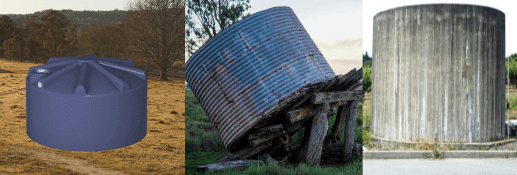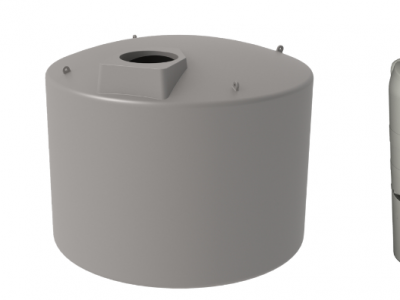
Rainwater Tanks come in a lot of different shapes, sizes and materials. But which one suits you? Read our list of advantages and disadvantages for Steel, Concrete and Polyethylene Tank materials to find out.
Steel
Galvanised steel is used for most Steel tanks as the zinc coating protects the steel from corrosion. Steel Tanks are great for conditions where exceptionally large storage is needed as they can be made to hold anywhere between 30,000 litres to millions of litres of water. Over time Galvanised steel still rusts and corrodes, the zinc can also leak out from the steel, giving your water a metallic taste. To avoid this happening most steel rainwater tanks are lined with food-grade polyethylene. Overtime though they can break and need repairing. Stainless Steel tanks are a lot more expensive that often make them less in our budget range.
Concrete
Whilst Concrete tanks are strong and long lasting, unfortunately, the durability of the tanks was effected when reinforcing steel in to the concrete was introduced. As the embedded reinforcing steel corrodes, the concrete can crack and break. There is also the issue of the lime found in concrete leaking into the water. Concrete Rainwater Tanks are generally installed underground for commercial purposes, but can be used for residential use as well.
Polyethylene Water Tanks
One of the most popular water tanks materials today is Polyethylene. As this is the type of material Poly Tanks Australia sells, we want you to buy this type of tank, but we also want you to buy the type that suits you best. So we will try to give you neutral information.
Some main benefits are:
- Strong, light-weight and more cost effective than alternative materials
- Flexibility of plastic allows for variety of styles and shapes
- Easier to install due to strength and lightness
- Wide range of colours to match your taste
- Colour is within poly material so tank remains looking new longer
- Non-corrosive so won’t taint rainwater with other substances
As poly tanks are made entirely from food-grade polyethylene, they have no need of the poly liners found in steel tanks. One disadvantage is that while poly tanks do not leak lime like concrete tanks, or zinc like steel tanks can, you must still be careful if you have copper plumbing throughout your home. Rainwater is naturally acidic and can cause copper to leak into the water if left in the pipes for some time. Plastic and plastic lined tanks are found to have this occur more commonly as the lime from the concrete tanks reduces the acidity of the water. You want to avoid this for the safety and health of you and your family. As dissolved copper in drinking water can cause gastric problems and headaches, and in severe cases cirrhosis of the liver. Applying proper filtration at the tap or simply flushing the first seconds of water out of the pipes that you drink or cook with, will make your water less acidic. Poly tanks can be made in sizes up to about 45,000 litres. Polyethylene is also recyclable and reusable, making them the green material of the 21st century.
Which Tank Material Suits YOU?



